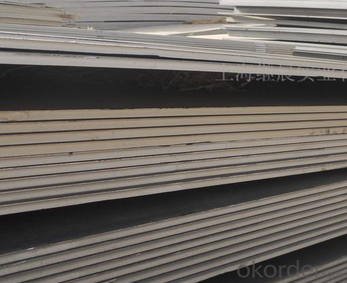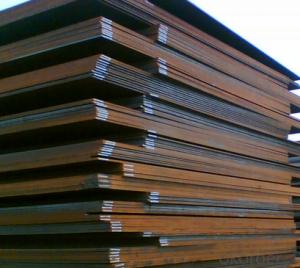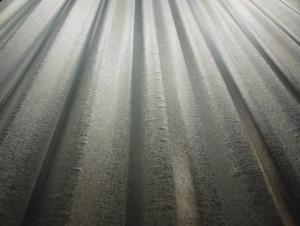Hot Rolled Carbon Steel Plate,Carbon Steel Sheet Q345C, CNBM
- Loading Port:
- Qingdao
- Payment Terms:
- TT OR LC
- Min Order Qty:
- 10 pc
- Supply Capability:
- 30 pc/month
OKorder Service Pledge
OKorder Financial Service
You Might Also Like
Quick Details
| Standard: | AISI, ASTM, GB, JIS | Grade: | Q195,Q235,Q345,A36,C45 | Thickness: | 1.0-30MM |
| Model Number: | Q235,Q195,Q345 | ||||
| Type: | Steel Plate | Technique: | Hot Rolled | Surface Treatment: | Coated |
| Application: | Ship Plate | Special Use: | Silicon Steel | Width: | 30-2000mm |
| Length: | as your requirement | standard: | hot rolled | Surface: | Anti-rust oil |
Packaging & Delivery
| Packaging Details: | seaworthy packages or as customers' require |
| Delivery Detail: | within 15 days after the advance payment |
Hot rolled steel plate
1 carbon steel plate 3mm thick General information
| Product name | Type | Specification | Implementation of GB | ||
| thick | wide | long | |||
| Carbon structural steel | Q195,Q215, Q235A,Q235B, Q235C,Q255, Q275 | 4-120 | 1500-4500 | 6000-12000 | GB/T700-2006 |
| Low-alloy structural steel | Q295,Q345A, Q345B,Q2345C | 4-120 | 1500-4500 | 6000-12000 | BG/T1591-1994 |
| Quality carbon structural stee | 30-50 | 4-120 | 1500-4500 | 6000-12000 | BG/T699-1999 |
| Ship steel | CCSA,CCSB | 4-120 | 1500-4500 | 6000-12000 | materials and welding condition |
| CCSAH32,CCSAH36 CCSDH32,CCSDH36 | 4-120 | 1500-4500 | 6000-12000 | materials and welding condition or GB 712-2000 | |
| Boiler steel | 20g,22Mng, 16Mng,19Mng | 4-120 | 1500-4500 | 6000-12000 | GB 713-1997 |
| Pressure vessel steel | 1622Mng,20R, 15MnVR,15MnVNR | 4-120 | 1500-2700 | 6000-12000 | GB 6654-1996 |
| European standard plate
| S235JR,S235J0, S275JR,S275J0, S275JR2,S355JR, S355J0,S355J2 | 4-120 | 1500-4500 | 6000-12000 | EN 10025 |
| Japanese standard plate | SS400,SS400-B | 4-120 | 1500-4500 | 6000-12000 | JIS G3101-2004 |
2 carbon steel plate 3mm thick detail specification
Material:
A283Gr.D/A573Gr.65,A516Gr65,A516Gr70,A284Gr.D
SS400,SS300,CCSB A36,A32,LRA32,LRB,Q235
Q195,Q235,Q345,SS400,ASTM A36,E235B
Thickness: 4mm-120mm
width: 1500mm-4500mm
Length:2-10m ,accordingly
Thickness | 4-120mm |
Width | 1500-4500mm or as custom's request |
Length | 2-12m,as your requirment |
Technique | Cold rolled or hot rolled |
Surface treatment | Bare, galvanized coated or as customer's requirements. |
Standard | ASTM,EN,GB,JIS,GB |
Material | A283Gr.D/A573Gr.65,A516Gr65,A516Gr70,A284Gr.D SS400,SS300,CCSB A36,A32,LRA32,LRB,Q235 Q195,Q235,Q345,SS400,ASTM A36,E235B |
Terms of Payment | L/C or T/T |
Chemical composition | C≤0.004%;Si≤0.030%; Mn ≤0.17%;P≤0.012%; S≤0.010%; Fe balance |
Delivery Detail | within 30days once receive deposite or confirm L/C |
Packing | Standard export packing,or as requirement |
3 carbon steel plate 3mm thick application:
construction,machinery manufacturing, container manufacturing, shipbuilding, bridge construction. Can also be used to manufacture a variety of containers, the furnace shell, furnace plate, bridge and vehicle static steel plate, low alloy steel plate,shipbuilding plate, boiler plate, pressure vessel plate, pattern plate, tractor parts, automobile frame steel plate and welding components
- Q: What is the difference between a painted and laminated steel sheet?
- Both a painted steel sheet and a laminated steel sheet belong to the category of steel sheets, but they offer distinct characteristics and applications. A painted steel sheet is a sheet of steel that has been coated with a layer of paint. This layer of paint serves two purposes: it protects against corrosion and enhances the sheet's appearance. The paint can be customized in terms of color and finish, allowing for versatility in design. Architectural applications, such as roofing, siding, and wall cladding, as well as the automotive and appliance industries, commonly utilize painted steel sheets. However, it is important to periodically maintain the paint layer to ensure its durability and appearance. On the other hand, a laminated steel sheet is created by bonding multiple layers of materials together. Typically, it consists of a steel core and one or more additional layers, such as plastic, polymer, or resin. The lamination process significantly strengthens and enhances the durability and performance of the steel sheet. These laminated steel sheets are highly resistant to impact, scratching, and chemical exposure, making them suitable for applications that require superior mechanical strength and protection. Industries such as transportation, construction, and industrial equipment manufacturing often utilize laminated steel sheets. Additionally, the laminate layers can provide added functionalities such as sound insulation, thermal insulation, or fire resistance. In conclusion, the main distinction between painted and laminated steel sheets lies in their composition and intended purpose. Painted steel sheets prioritize aesthetics and corrosion protection, while laminated steel sheets prioritize strength, durability, and specialized functionalities. The choice between the two depends on the specific requirements of the given application.
- Q: What is the difference between a brushed and polished steel sheet?
- A brushed steel sheet has a textured surface created by brushing the steel with a fine abrasive material, while a polished steel sheet has a smooth and reflective surface achieved by polishing the steel to a high shine.
- Q: How do steel sheets perform in weather resistance?
- Steel sheets are highly weather resistant due to their durable composition and protective coatings, making them resistant to corrosion, rust, and extreme weather conditions.
- Q: Can the steel sheet pile retaining structure be watertight and impervious?
- If the channel is certainly not, but Larson type steel sheet pile is able to, and the effect is not bad.
- Q: What are the different edge treatments available for steel sheets?
- Some of the different edge treatments available for steel sheets include shearing, deburring, chamfering, edge rounding, and edge conditioning.
- Q: Can steel sheets be used for manufacturing medical devices?
- Yes, steel sheets can be used for manufacturing medical devices. Steel is often chosen for its durability, strength, and resistance to corrosion, making it suitable for various medical applications such as surgical instruments, implants, and equipment components.
- Q: How do steel sheets perform in electrical resistance?
- Steel sheets are not good conductors of electricity and have relatively high electrical resistance compared to other materials such as copper or aluminum.
- Q: Can steel sheets be used in the aerospace industry?
- Yes, steel sheets can be used in the aerospace industry.
- Q: Are the steel sheets suitable for HVAC applications?
- Yes, steel sheets are suitable for HVAC applications. Steel has excellent strength and durability, making it ideal for use in HVAC systems where it can withstand high temperatures, pressure, and corrosive environments. Additionally, steel sheets can be easily fabricated and shaped to meet specific requirements of HVAC components such as ductwork, heat exchangers, and ventilation systems.
- Q: What are the different sheet metal welding techniques for steel sheets?
- There are several sheet metal welding techniques commonly used for steel sheets, including spot welding, seam welding, and TIG welding. Spot welding involves joining two metal sheets by applying pressure and heat at specific points, creating a strong bond. Seam welding, on the other hand, involves continuously welding along the length of a joint, creating a continuous welded seam. TIG welding, also known as tungsten inert gas welding, uses a non-consumable tungsten electrode to create an arc that melts the metal, forming a weld pool that fuses the steel sheets together. Each technique has its own advantages and is chosen based on the specific requirements of the project.
Send your message to us
Hot Rolled Carbon Steel Plate,Carbon Steel Sheet Q345C, CNBM
- Loading Port:
- Qingdao
- Payment Terms:
- TT OR LC
- Min Order Qty:
- 10 pc
- Supply Capability:
- 30 pc/month
OKorder Service Pledge
OKorder Financial Service
Similar products
Hot products
Hot Searches
Related keywords


























